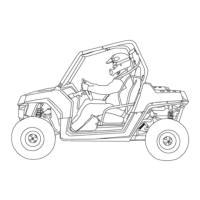5 - 23 ELECTRICAL
GEM Service Manual November 2007
PROPER TORQUE VALUES FOR CONNECTION
HARDWARE
Deka 8V Gel Batteries – 95 - 105 in-lbs.
Deka 12V Gel/EV31 Batteries – 120 - 180 in-lbs.
CAUTION: Do not over tighten terminals. Doing
so can result in post breakage, post meltdown,
and internal battery damage.
TESTING
Visual inspection alone is not sufficient to
determine the overall health of the battery. Both
open circuit voltage and specific gravity readings
can give a good indication of the battery's charge
level, age, and health. Routine voltage and gravity
checks will not only show the state of charge but
also help spot signs of improper care, such as
undercharging and over-watering, and possibly
even locate a bad or weak battery. The following
steps outline how to properly perform routine
voltage and specific gravity testing on batteries.
NOTE: Temperature in the following section
refers to electrolyte temperature not ambient
temperature.
SPECIFIC GRAVITY TEST FOR FLOODED
(WATER BASED) BATTERIES
1. Do not add water at this time.
2. Fill and drain the hydrometer 2 to 4 times
before pulling out a sample.
3. There should be enough sample electrolytes in
the hydrometer to completely support the float.
The float should be floating freely and not
touching the sides of the cylinder.
4. Take a reading, record it, and return the
electrolyte back to the cell.
5. To check another cell, repeat the 3 steps
above.
6. Check all cells in the battery.
7. Replace the vent caps and wipe off any
electrolyte that might have been spilled.
8. Correct the readings to 80° F:
• Add 0.004 to readings for every 10° above
80°F.
• Subtract 0.004 for every 10° below 80° F.
9. Compare the readings.
10. Check the state of charge using Table 1.
The readings should be within the factory
specification of 1.277 ± 0.007. If not, follow the
steps below.
1. Check and record voltage level(s)
2. Put battery(s) on a complete charge.
3. Take specific gravity readings again.
If any specific gravity reading is still not within the
factory specification, follow the steps below.
1. Check voltage level(s).
2. Perform equalization charge.
3. Take specific gravity readings again.
If any specific gravity reading is still not within the
factory specification of 1.277 ± 0.007 then one or
more of the following conditions may exist:
1. The battery is old and approaching end of life.
2. The battery was left in a state of discharge too
long.
3. Electrolyte was lost due to spillage or overflow.
4. A weak or bad cell is developing.
5. Battery was watered excessively previous to
testing
NOTE: Batteries in conditions 1-4 should be
taken to a specialist for further evaluation or
retired from service.
OPEN-CIRCUIT VOLTAGE TEST
For accurate voltage readings batteries must
remain idle (no charging, no discharging) for at
least 6 hrs. Preferably for 24 hrs.
1. Disconnect all loads from the batteries.
2. Measure the voltage using a DC voltmeter.
3. Check the state of charge with Table 1.
4. Charge the battery if it registers 0% to 70%
charged.
If battery registers below the Table 1 values, the
following conditions may exist:
1. The battery was left in a state of discharge too
long.
2. The battery has a bad cell.
Batteries in these conditions should be taken to a
specialist for further evaluation or retired from
service.

